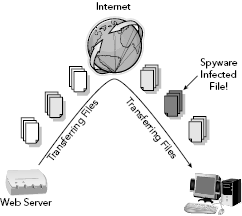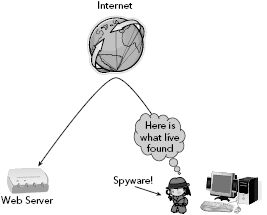Viruses and Other Infections
A computer virus is a form of malicious software, also referred to as malware—a catch-all term for computer programs or executable code that do bad or unwanted things. Viruses can do the following if left unchecked:
- Damage or delete files. Some viruses may delete or damage random documents or specific files that are crucial to your operating system—for example, Windows XP system files.
The damage caused by viruses can range from rendering useless just a few files to affecting your entire computer, possibly requiring you to reinstall your operating system and start from scratch.
- Slow down your computer. Viruses can run in the background, without being seen, and may cause your computer to run extremely slow.
- Invade your email program. Some forms of viruses may wreak even more havoc by spreading themselves to the contacts in your address book.
Here are the main forms of viral infections, which are commonly referred to as viruses:
- Virus - A “generic” computer virus is a small program that attaches itself to another program or document, such as a word processing document, and replicates it with the potential to cause damage to your computer. A more common type of virus is one that “invades” your email program and spreads to contacts in your address book.
- Worm - This type of virus is specifically engineered to make extensive use of email and security holes in software or operating systems to spread rapidly.
- Trojan - This is a type of program that pretends to be something harmless, but has a damaging or otherwise malicious intent.
For example, a person may get a program by email or the Internet that he or she thinks is a computer game; however, when the person runs the supposed game, the program deletes files on the computer or injects viruses.
Spyware is a malware that is placed secretly on a computer. It tracks the user’s behavior and reports information back to a central source. Some types of spyware are simply annoying because they cause increased spam or unwanted pop-ups, but others can go so far as to threaten the security of your PC and personal information.
Spyware can act like a peeping tom or, at worse, a geeky thief. For example, it:
- Can be installed on your PC without your consent. Typically, spyware finds its way onto PCs by “piggybacking” onto a file, such as a computer game, a music file, or a free software program (as shown in Figure 1), or it can be downloaded from the Internet when you visit a particular website.
Pests such as spyware can often lurk silently on your computer until someone or something sets them off, or until they are found and properly removed.
- Compromises your data, computing habits, and identity. Spyware can monitor information about your computing habits, such as what websites you visit, or record your keystrokes, which in the end can lead to identity theft.
For example, spyware can record the keystrokes that you use while keying in a credit card number and send this number to a “cyberthief.” Figure 2 shows an example of how spyware sends your information to an unwanted, central source.
- Alters PC settings. Some forms of spyware can also wreak havoc by altering computer settings like your web browser home page setting or the placement of your desktop icons. This doesn’t do much damage to your PC, but it’s really annoying.
- Slows down your PC. Spyware can rob your PC of system speed and Internet access efficiency. This can become a big problem when you’re trying to use the programs on your PC, watch videos online, or download large files.
Adware is similar to spyware—however, it may be installed with your consent. Therefore, make sure you thoroughly read installation agreements. Often there are clauses in the agreement that legally specify the installation of adware. In most cases, you probably won’t notice these statements unless you read the agreement carefully.
Adware comes complete with the following disadvantages:
- Adware takes a step further than spyware. Just as with spyware, your Internet habits such as the sites you visit are tracked. In addition, however, adware uses that information to produce targeted advertising, such as pop-up ads, on your computer screen.
- Displays arrays of annoying advertising. When infected with adware, you will likely see frequent pop-up ads appear out of nowhere. This may even happen every time you open your web browser.
- Slows down your PC. The adware software working in the background and the bombardment of ads can slow your PC to a crawl.
After hearing descriptions of “spyware” and “adware,” 43% of Internet users, or about 59 million American adults, say they have had one of these programs on their home computer.
Although most do not know the source of their woes, millions of home Internet users have experienced computer problems in the past year that are consistent with problems caused by computer pests and malware. For example, here are some statistics that indicate the presence of malware:
- 52% of home Internet users say their computer has slowed down or is not running as fast as it used to.
- 51% of home Internet users say their computer started freezing up or crashing, requiring them to shut down or restart.
- 25% of home Internet users say a new program appeared on their computer that they didn’t install or new icons suddenly appeared on their desktop.
- 18% of home Internet users say their Internet home page changed without them resetting it.
In sum, 68% of home Internet users, or about 93 million American adults, have experienced at least one of these problems in the past year. Sixty percent of Internet users who report computer problems do not know the source, but others cite viruses, spyware, adware, operating system flaws, and hardware glitches as the culprits.
Not everyone attempted a fix, but those who did often found that they needed help, paid or unpaid. About 28 million American adults ended up spending at least $100 to get their computer working again.
The threat of unwanted programs being secretly loaded onto computers is becoming a serious matter. As a result, many online users have begun to take precautions by changing the way they use the Internet.
Overall, 91% of Internet users say they have made at least one change in their online behavior to avoid unwanted software programs. Here are some of the changes:
- 81% of Internet users say they have stopped opening email attachments unless they are sure these documents are safe.
- 48% of Internet users say they have stopped visiting particular websites that they fear might deposit unwanted programs on their computers.
- 25% of Internet users say they have stopped downloading music or video files from peer-to-peer (P2P) networks to avoid getting unwanted software programs on their computers.
- 18% of Internet users say they have started using a different web browser to avoid software intrusions.

